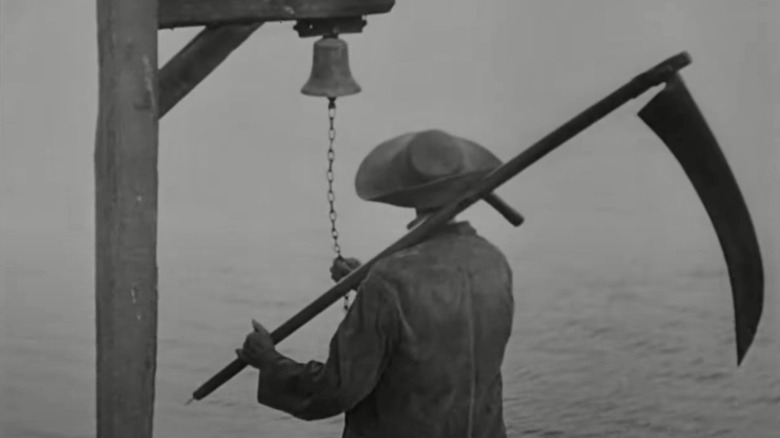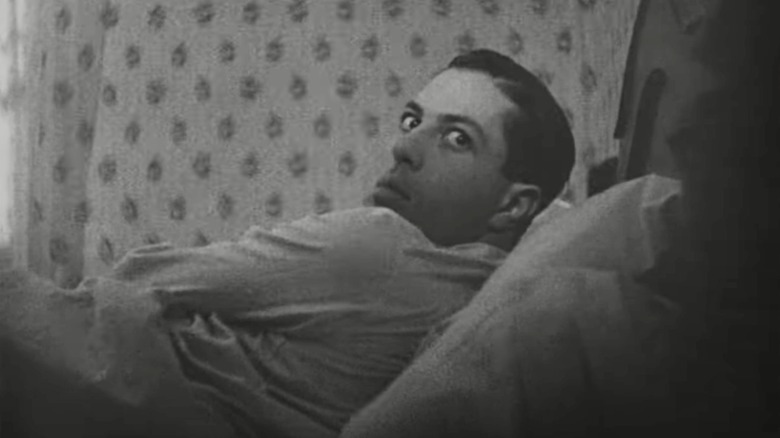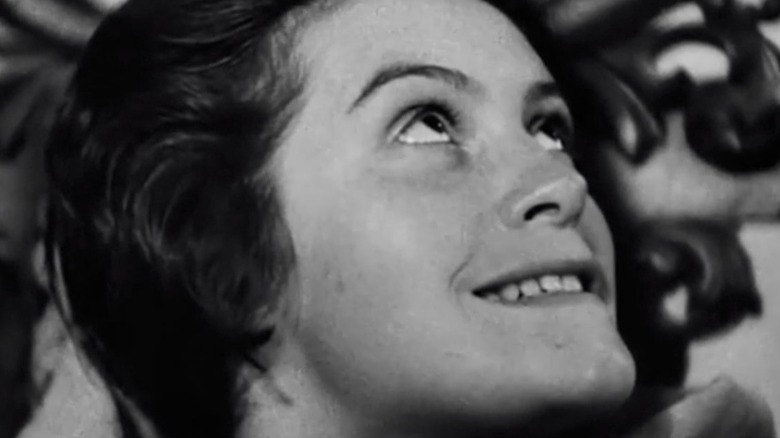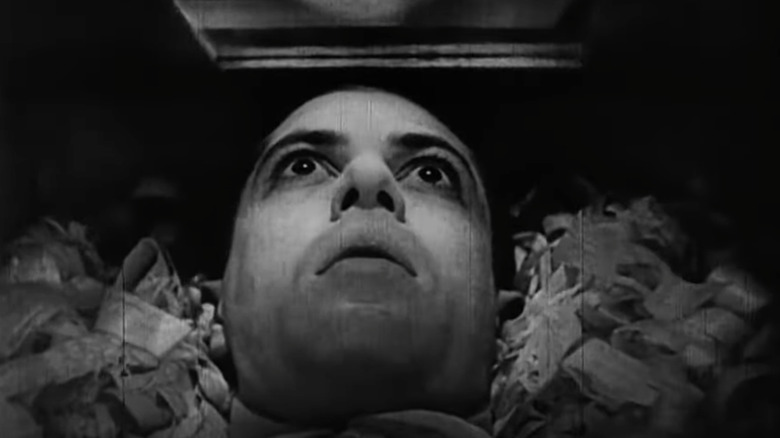Year Of The Vampire: Carl Theodor Dreyer's Vampyr Is A Waking Dream Inside A Coffin
(Welcome to Year of the Vampire, a series examining the greatest, strangest, and sometimes overlooked vampire movies of all time in honor of "Nosferatu," which turns 100 this year.)
Allan Gray chases shadows. That sounds like a metaphor, and maybe it is one. However, it's also what Gray, played by Julian West (the screen name of Baron Nicolas de Gunzburg), does in a literal sense as he wanders around a sleepy European village looking for supernatural adventure in Carl Theodor Dreyer's "Vampyr."
One shadow has a peg leg; others enjoy dancing and digging. Yet by chasing them, what Gray really seeks to do is transcend the mundane. He's not so different from a genre fan looking to escape the boredom of real life and just get lost in a good story.
Is there a danger in that kind of escapist urge? Gray is a neutral color, and as West's character checks himself into an inn in Courtempierre, France, he begins to inhabit a dream world where a person might soon pass from the living realm into a state of waking death.
The knob on his door turns, and Gray turns over in bed to see a stranger entering his room. Later, we see him staring up through the window of a coffin, neither dead nor truly alive anymore. He's not the vampyr here, but he might as well be. Speaking directly to the interests of us culture vultures (or culture vampires) who harbor a lingering fascination with occult subject matter, "Vampyr" begins with the words:
"This is the tale of the strange adventures of young Allan Gray, who immersed himself in the study of devil worship and vampires. Preoccupied with superstitions of centuries past, he became a dreamer for whom the line between the real and the supernatural became blurred."
Why it's essential viewing
Released in 1932, the year after Universal's "Dracula" with Bela Lugosi, "Vampyr" was on the frontlines of the earliest vampire movies and it held the embryos of future genre titles within its 73-minute runtime. This was Dreyer's first sound film after the silent classic "The Passion of Joan of Arc," and with it, he and co-screenwriter Christen Jul adapted parts of Sheridan Le Fanu's 1872 short story collection, "In a Glass Darkly," including the final tale, "Carmilla," which received more straightforward treatment in 1970 with Hammer's "The Vampire Lovers."
Here, the figure of the vampire is no longer just an outside threat, but rather one that might eat away at families from within. "The Wurdulak" — notable for being the one time "Frankenstein" star Boris Karloff played a vampire — would draw on a similar tradition in 1963. We also see the seeds germinating for vampirism as a form of teen rebellion in Dreyer's film.
Gray is the prototypical paranormal investigator, trolling for action like one of those ghost hunters you'd see on a reality show where they have to manufacture excitement out of uneventful events. The shadows leading him around are perhaps external manifestations of his own fancies, but eventually he does witness a real murder.
The victim is the Lord of the Manor (Maurice Schutz, who co-starred in "The Passion of Joan of Arc"). Before his death, said Lord happened to come puttering into Gray's room at the inn, much to the confusion of our hero, who was, as we've established, in bed at the time: half-awake, half-alive. Without identifying himself or explaining what he was doing, the Lord left a parcel there, to be opened upon his death, and it turns out this pregnant parcel holds the secrets of the "strange history of vampires."
The school of found literature and proto-YA
"Vampyr" is a German-language film, but it's one that is sparse in dialogue, as Dreyer and the filmmaking world in general were still getting used to working with sound. Let's face it: if Bram Stoker (who was, after all, a theater critic and an actor's business manager) were to write "Dracula" today, he wouldn't write it at all; he would film it as found footage. "Vampyr" comes closer to the "found literature" school of Stoker's epistolary novel when it has Gray consulting a book the dead Lord left behind for him.
Some important information comes from the pages of this book, which is repeatedly displayed onscreen in "Vampyr." Through it we learn the nature of vampires, that their "terrible deeds in life deny them repose in the grave." Their killing M.O is "to suck the blood of children and young adults and thus prolong their shadowy existence."
It's as if the movie foresaw the 21st-century breaking dawn of Y.A. vampire movies and TV shows. In "Vampyr," an innocent young person "becomes a vampire and seeks to prey on its nearest and dearest." Its curse falls on "entire families, even entire villages."
Witness the mood swings of the Lord's infected daughter, Léone (Sybille Schmitz), who says, "I know. I'm lost. I'm damned." When you're a hormonal teen, everything feels like the end of the world. What's scary is how quickly a change comes over Léone's face; now she leers up at her sister with an evil grin, and the camera takes on her predatory POV, the way the camera in "The Lost Boys" would with that film's flying vampires. Guillermo del Toro, an avowed admirer, has noted how "the camera is more than a witness; it's an active participant in the narrative."
From dust thou art
In "Vampyr," the camera looks around the room and down at the dying Lord, and we share its first-person impressions as Gray has an out-of-body experience and confronts his own mortality. The bell tolls for him. Rudolph Maté, who framed the many close-ups in "The Passion of Joan of Arc," was the cinematographer for "Vampyr," and it bears signs of the same "Häxan" influence. Offscreen, West/Gunzburg (who also co-produced) would later work as a fashion editor for Vogue and make the International Best-Dressed List Hall of Fame. When you put a man like that in city clothes in a village, it gives a whiff of folk horror.
The bloodsucker in "Vampyr" is an old woman with a cane named Marguerite Chopin. She's a phantom character who comes drifting out of the haze, putting young people like Léone in her thrall and driving them to ingest poison.
She may have a little help in that regard. No sooner does Gray finish reading about a village doctor who became a vampire's henchman and an accessory to its crimes, than a doctor shows up to pay Léone a house call.
Vampirism is again associated with sickness, the kind of plague that overtook villages in Europe and has once again overtaken the modern world with the current pandemic. There's a blood transfusion, an iron stake instead of a wooden one, and moments of wide-eyed terror in Gray's brush with undeath. At what point does chasing dreams and shadows go too far and impede one's ability to move through life naturally?
Ninety years later, "Vampyr," like Chopin, is getting a little long in the tooth, but if you give yourself over to it, this offbeat, grainy old black-and-white film still has plenty of bite left in it.



